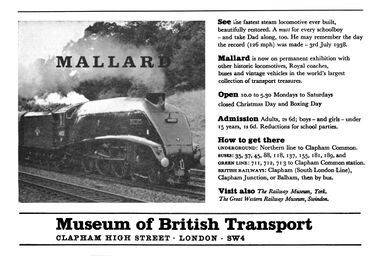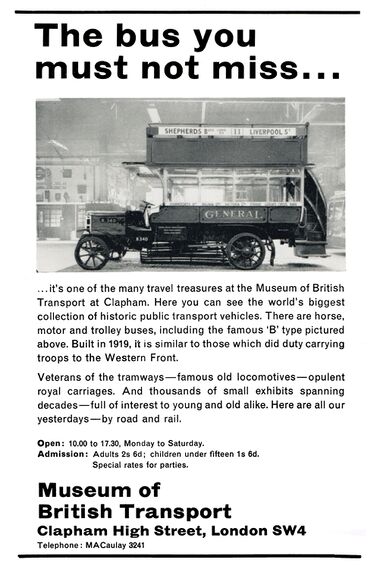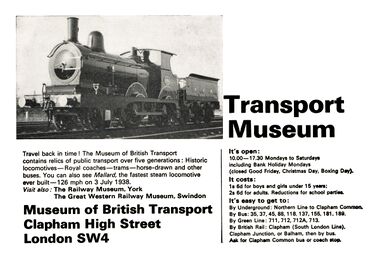Museum of British Transport
1964: Mallard [image info]
1966: "The bus you must not miss", Museum of British Transport, Clapham [image info]
1967: Advert, Meccano Magazine [image info]
The Museum of British Transport opened in 1961 (with the main gallery opening in 1963), and was located in Croydon, London, until 1973.
The collection originated in the 1920s, when the London General Omnibus Company decided to preserve two Victorian horse buses and an early motorbus for future generations. The Museum of British Transport opened in an old bus garage in Clapham, south London, during the 1960s, before moving to Syon Park in west London in 1973 as the London Transport Collection.
In 1980, the public display moved again, this time to occupy the Victorian Flower Market building in Covent Garden as London Transport Museum.
— , London Transport Museum, , A brief history of London Transport Museum,
1966 advert text:
The bus you must not miss ...
... it's one of the many travel treasures at the Museum of British Transport at Clapham. Here you can see the world's biggest collection of historic public transport vehicles. There are horse, motor and trolley buses, including the famous 'B' type pictured above. Built in 1919, it is similar to those which did duty carrying troops to the Western Front.
Veterans of the tramways — famous old locomotives — opulent royal carriages. And thousands of small exhibits spanning decades—full of interest to young and old alike. Here are all our yesterdays by road and rail.
Open: 10.00 to 17.30, Monday to Saturday.
— , Museum of British Transport, , advert, HCVS London-Brighton Run programme, , 1966
1966 promotional text:
Clapham Museum
It is appropriate that Clapham should be the starting point of today's run for it is a site steeped in transport history. During the last century horse trams of the London Tramways Company ran from there on services from Tooting to Blackfriars, Westminster and Vauxhall Bridges. On the 1st January, 1899, the L.C.C. took over and, with electrification in the offing, the depot was completely rebuilt in about 1903. Then followed almost half a century of electric tram operation until the 1st October, 1950, when motor buses were first garaged there at the start of the post-war tram replacement programme. The buses ran side by side with the trams until the 6th January, 1951, when Clapham's last trams went for scrap. At this time the depot was gradually being rebuilt without any interruption to the services operating from it, and today's very fine building was the result. Clapham's role as a garage was quite short and it was closed in November 1958 as an economy measure.
It was then that the British Transport Commission took over in the shape of Mr. J. H. Scholes and his department who began to establish the Museum of British Transport there. The department had actually been in existence since 1951 but this was the first time that it had been given a permanent roof over its head in London under which to display its collection of historical items which by that time had become the largest in the world. On the 29th March, 1961, the former office building at the Triangle Place entrance to the depot was opened to the public and many of the Museum's small exhibits were to be seen for the first time. In the six galleries items of road, rail and water transport history were beautifully arranged and displayed under the guidance of Mr. Peter Miller, A.B.I.A., M.S.I.A. The main gallery (the former depot building itself) which houses the Museum's famous collection of full-size relics, including railway locomotives and carriages, buses, tramcars, trolleybuses and lorries, was opened on 29th May, 1963. In common with the railway museums at York and Swindon, Clapham is now under the direct control of British Railways.
This unique exhibition is something that everyone interested in transport should make a point of visiting. It is open every weekday from 10 am. to 5.30 p.m., and a special Sunday opening has been arranged for today, May 1st, so that people watching the start of the Run in London may have a convenient opportunity of visiting the museum afterwards.
— , Museum of British Transport, , HCVS London-Brighton Run programme, , 1966
External links
- photo: Museum of British Transport, Clapham, 1966 (nrm.org.uk/)
- Decision to move museum north angers Londoners (theguardian.com) – 3 May 1969: "Artefacts will be moved from the Museum of British Transport to the Railway Museum in York"
- About Us (ltmuseum.co.uk)





